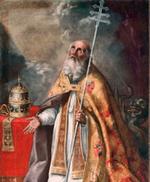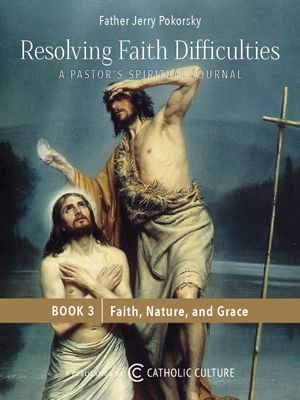Catholic Activity: St. Nicholas Puppet Show
We find a puppet show a delightful way to tell St. Nicholas' story, explain his relation to the Christ Child, and introduce the hanging of stockings for his feast day. Fashion puppets and a stage, and then perform this festive puppet show to celebrate the feast day of St. Nicholas.
DIRECTIONS
Our puppets are made from socks — a white one for St. Nicholas and a navy blue for Black Peter (we didn't have brown or black clean that day). St. Nicholas is the toe of a white sock stuffed with cotton batting until there is a firm egg-shaped head. A rubber band is wound several times at the base of this to make the neck. Two slits are cut on each side of the sock under this, close to the neck. The index finger goes up through the rubber band into the head to wag the head; the thumb and third fingers go through the two slits to make arms. The anatomy of the puppet is done.
His face can be drawn on with heavy pencil, paint, even a ballpoint pen; St. Nicholas has pink cheeks and bright blue eyes (although it occurs to us that most Turks have black). White yarn sewed across his mouth from ear to ear makes his full beard; sewed on around a baldpate, it makes his hair, which hangs to his shoulders.
His alb is a white flounce sewed together like a cuff, gathered at the neck and tacked under the chin, and trimmed with odds and ends of lace. His cope is a piece of red velveteen with green braid trim, and his mitre is cut from stiff white paper and trimmed with a green braid cross stitched or glued or painted on. A piece of white braid stitched across the bottom of the mitre ties snugly under his hair at the back, holding it in place. Blind sleeves may be put in his garments, but even without them the two fingers can be managed to give the illusion of arms.
Black Peter has a garment of red lamé cut from an old blouse and worn under a navy blue cape tied with green and red wool tassels. He has sleeves that come through slits in his cape so that he can maneuver his hands better in the play. On his head is a tam-o'shanter of red lame with a long pheasant feather in it. His gay face is made with white paint for the whites of his eyes and his bright white teeth, and red for a wide-open, laughing mouth. Black Peter may be dressed to suit any fancy, but St. Nicholas always appears in his white alb and mitre and red cope.
The puppet stage is made from a three-panel screen. We unhinged the panels and cut a large square window in the top half of the center panel to make the stage. Slip covers of bright muslin went over the panels; and with an old curtain of flounces and ball fringe we made a curtain for the top and sides of our stage. We rehinged the panels so that the sides would fold back and — presto! — a puppet show.
Friends of ours sewed two deep flounces like half-curtains to be tacked across the top and middle of a doorway with the space between for the stage. We have also had successful hand-puppet shows staged from behind a chair, and from behind a couch. There is no place where a hand-puppet show cannot be staged. No stage is no excuse. The year we made our stage from the screen it was the children's big Christmas gift. Prior to that we had staged impromptu shows anywhere and everywhere.
THE VIGIL AND THE FEAST
One of the traps into which most parents of good will eventually fall before Christmas has arrived is to shout in the heat of some shortness of tempers: "How do you expect to get presents on Christmas if you aren't good now!" No sooner are the words out of your mouth than you could bite off your tongue. But it has been said. The ugly implication is there: you might not get presents for Christmas. St. Nicholas' feast is an ideal time for straightening out this problem of being good and not being good before Christmas. It is true that the issue should have something to do with the end result, but when we threaten this way we forget that the reason God the Father sent the Christ Child wasn't because everyone had been good, but because they hadn't been good.
To transfer the burden of the "be good or else" problem to St. Nicholas is infinitely more comfortable. Here the threat involves no more than a stockingful of cookies, but it is a prospect sufficiently dreadful to give them pause. It also involves a happy solution to the naughtiness. No good behavior — no cookies. It usually works (I speak from experience). The shock of seeing that you meant what you said, of hearing St. Nicholas en poupée warn you the night before and discovering he meant what he said, is most salutary. Most enfants terribles will stand dolefully watching the more virtuous munching their cookies and make a superb effort to mend their ways, and yet the event is not of such magnitude that it leaves any permanent scars.
People always ask how we handle the delicate business of sharing should this occasion produce one or two malcontents without cookies. We are all of course very sad to see they have no cookies, but if it is a warning and a punishment, then it is a warning and a punishment. Character training is involved, and also your own authority. No cookies — shared or otherwise.
Everyone assembles after dinner on December 5, the vigil of the feast, and the puppet show begins. First St. Nicholas appears, bowing with dignity and murmuring: "Thank you, thank you," to the shouts and clapping. He has a Dutch accent (just for merriment), and if your accent isn't all it might be, frequent interpolations of "Jah, jah" convince all present that it is superb.
"Good evening, little children," he says. "I am St. Nicholas. Jah — a real saint I am, in Heaven now, and my feast is celebrated tomorrow. You are going to celebrate my feast? Jah?
"I am not, you know, the reason for Christmas. Even though I am sometimes called Santa Claus, I am not the reason for Christmas. Oh no. Baby Jesus is the reason for Christmas. It is His birthday, Christmas, the day His Father in Heaven gave Him to all of us.
"I am waiting in Heaven, now, like you on earth, for His birthday on Christmas Day. And do you want to know something? That is why I gave gifts to little children when I was on earth! Because I was so grateful to God the Father for giving Jesus to me. That is why we give each other presents on Christmas Day, because we are full of joy and gladness that Jesus came down to be one of us and to die to pay for our sins.
"Now, here is something you may do for my feast, and it pleases me very much. You hang your stockings tonight, and if you are very good children — you will get cookies in them! But if you are bad — ! Ahhh — if you are bad, you will get — not cookies — but straw! Black Peter will put straw in them."
Up pops Black Peter, giggling and snickering and wagging his hands at the audience, which promptly rolls on the floor and shrieks.
The Bishop is grave. "Peter! Peter! Behave yourself or I will have to use a switch on you! Peter, you are going to put straw in some stockings? Jah?"
Peter looks coy, cocks his head, and makes odd noises that say neither Aye nor Nay.
"Ah — he will not tell. Peter, be fair now. No straw for the good children, you know. But be honest as well — straw for the naughty ones!"
Peter snickers again, wags at the children, then turns and throws himself on the Bishop, arms around his neck, mewing noisily. As the Bishop nods his head paternally, Peter slyly turns to the children, waves a free arm and giggles. Then he quickly buries his head in the Bishop's shoulder again.
After this you can have Peter sing a song or two and the Bishop can end the play with a hymn and lead the children in a little prayer or two, asking for the grace to be good and to love little Jesus with all their hearts.
Then it is all over. All go rushing about looking for stockings, full of high hopes for cookies — which of course they have spent the afternoon helping to make (or seen Mother buy).
The following morning tells the tale and it is sometimes a mixture of fun and bittersweet. We have a little friend named Teddy who was unable to bear the suspense; so he bade his sister look in his stocking for him. When she reported, "Cookies!" he was so amazed (what with the weight of his past sins pressing so hard upon him) that he gasped: "Are you sure?"
Activity Source: Year and Our Children, The by Mary Reed Newland, P.J. Kenedy & Sons, New York, 1956






